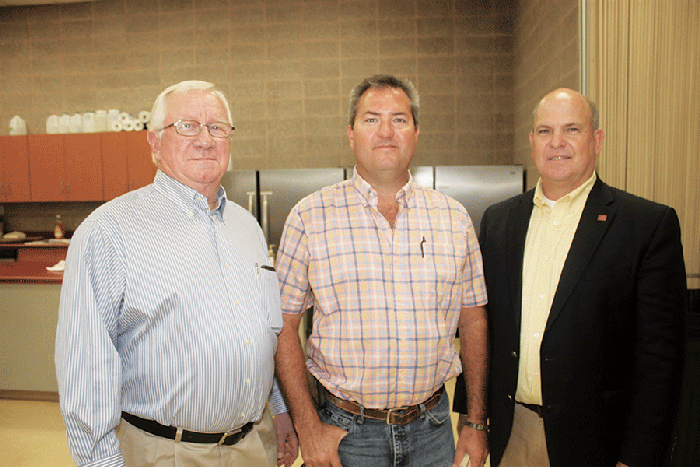
Despite the rainy spring and abundant wild host plants, says Dr. Angus Catchot says, plant bugs in cotton “were are about what I’d call normal — which was “a welcome surprise, because we did a lot of ditchbank surveys earlier in the year and I’ve never seen as many plant bugs on wild hosts.”
But while there were are a few hot spots, he said at the annual meeting of the Mississippi Boll Weevil Management Corporation and the Mississippi Farm Bureau Federation Cotton Policy Committee, “the frequent and often heavy rains kept them somewhat in check, and for the most part we are currently experiencing a low to moderate plant bug year on average.”
Catchot, Mississippi State University Extension entomology professor, cautions growers not to let their guard down, however — “with cotton moving into the bloom stage, plant bugs are coming; I expect their numbers to increase in coming weeks.”
Welcome news for growers, he says, is the EPA’s Section 18 approval of Transform, which is “at the top of the list for plant bugs and aphids. Aphids this season have been a bigger problem, on a wider scale, than in a number of years — not just in Mississippi, but across the entire South. We don’t have a lot of products any more that control both plant bugs and aphids, which Transform will do.
“Imidacloprid products, which everyone wants to use, aren’t that great for plant bugs or aphids in the Delta region. They have more utility in the hills. But they generally don’t work quite as well on a multiple pest spectrum. Centric, at pre-bloom, would probably be a preferred product on plant bugs, if you want to go the neonicotinoid route, but we no longer recommend it for aphids.
“The product bucket that we’re pulling from for a multiple pest spectrum is definitely small. So, how do you kill plant bugs and aphids? Right now, it’s pretty much Transform. We really need this product. This year, in particular, proves that point.”
To that end, Catchot says, “I can’t emphasize enough how important it is that growers make their voices heard when the EPA has comment periods on products such as Transform. In meetings with EPA officials, they have told us over and over how important grower comments are.

Farrell Boyd, from left, program director for the Mississippi Boll Weevil Management Corporation, Clinton, Miss.; Preston Aust, Humphreys County Extension agent, Belzoni; and Mike McCormick, president of the Mississippi Farm Bureau Federation, were among those attending the joint annual meeting of the boll weevil organization and the Farm Bureau’s Cotton Policy Committee.
“Pyrethroid reviews are coming up soon, and a neonicotinoid review. Please give the EPA your two cents worth on these products, and anytime a comment period is open for an ag chemical. Don’t just say, ‘We need this product’; instead, tell them how you use the product on your farm, how you use it responsibly, and what it means to your operation.That’s the kind of comments they’re looking for, and your input, as a farmer, will go a long way in giving the EPA information they need to approve these products that we desperately need.”
Now that farmers are getting a reprieve from all the rains, Catchot says, “spider mites are showing up pretty heavily in a lot of places, and a lot of treatments are going out. Abamectin seems to be the product of choice, mainly because of price, he says.
“If you’re still using the EC formulation, I wouldn’t use less than 10 ounces to 12 ounces. If you’re using the SC formulation, which is heavier-loaded, I would stay between 2.1 ounces and 3 ounces, which is equivalent to 10-14 ounces of the EC formulation. The days of using 4 ounces to 8 ounces of the EC formulation are over — I just wouldn’t do it; we’ve seen problems with that.

“Pyrethroid reviews are coming up soon, and a neonicotinoid review,” says Dr. Angus Catchot, Mississippi State University Extension entomology professor. “Please give the EPA your two cents worth on these products, and anytime a comment period is open for an ag chemical it’s important that you submit your views.”
“Other than abamectin, we’ve got Portal, Zeal, and if you can find it, Oberon. There are a few other products, but I know everyone’s going straight to abamectin because of price. That’s all right as long as it’s working, and so far it seems to be working OK.
“Now is about the time (July 7) you’re going to start finding some worms,” Catchot says. “I’ve been getting numerous reports this week of bollworms in soybeans and cotton. From now through about July 15, we can expect the first big bollworm flight.
“There’s a lot of Bollgard II cotton this year, but Bollgard doesn’t necessarily protect you from bollworms. It will go a long way in helping, but the cotton has to be scouted — and it will need to be sprayed on occasion. Last year was a pretty big year for spraying Bollgard II cotton. We need to watch all of these technologies closely and treat according to threshold."
About the Author(s)
You May Also Like




